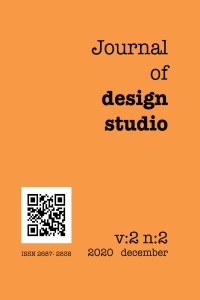Abstract
This text discusses an experimental pedagogical method coded as from ‘section-model to space’. The theory of the study is the integration of basic design exercises and the architectural project studio. Instead of the disconnected understanding of the architectural project studio with basic design exercises, outputs of the two studios are integrated and design processes come to the fore as a new learning setup. The main idea of the method is to find transformations from basic design models and to benefit from basic design principles in an architectural design of a building. Methods proceed through the various design variables by giving the architecture students a fixed design resource that includes practicing the space through a sectional model. The fixed variable in the design research is the output of basic design exercises. Sectional models, which are open to continuous improvement, are experimental tools that initiate a formal organization. This experiment was adopted with a ritual of repetitions; at the end of the process, practical and survey-based inquiries were carried out to test the theory. As a result, the method leads architecture students to analyze spatial design in terms of relationship between the third dimension and tectonic content. Also, it has been observed that the process offers opportunities for empirical research. It was found that the interaction in the studio environment increased with all these models.
Supporting Institution
-
Project Number
-
References
- Alangoya, K. A. (2015). ‘Tasarımcı düşünce’ geleneğinin maceracı yapısı ve kentsel tasarım eğitimine katkısı üzerine deneysel bir kentsel tasarım stüdyosu: “iz üstünde taksim meydanı” METU JFA, 32 (1), 65-89.
- Arnheim, R. (2009). The dynamics of architectural form. (2nd ed.). Berkeley-Los Angeles-London: University of California Press.
- Asar, H. (2018). Mimari temsil araçlarından maketin tasarım düşüncesindeki yeri. Tasarım ve Kuram Dergisi, 26, 24-35.
- Ciravoğlu, A. (2014). Notes on architectural education: an experimental approach to design studio. Social and Behavioral Sciences, 152, 7-12.
- Demirbaş, O. O., & Demirkan, H. (2003). Focus on architectural design process through learning styles. Design Studies, 24, 437-456.
- Galle, P. (2011). Foundational and instrumental design theory. Design Issues, 27(4), 81-94.
- Goldschmidt, G. (1983). Doing design, making architecture. JAE, 37(1), 8-13.
- Goldschmidt, G. (2017). Design thinking: a method or a gateway into design cognition? The Journal of Design, Economics, and Innovation, 3(2), 107-112.
- Oxman, R. (2004). Think-maps: teaching design thinking in design education, Design Studies, 25, 63-91.
- Paker Kahvecioğlu, N. (2007). Architectural design studio organization and creativity. ITU A/Z, 4(2), 6-26.
- Reynolds, C. (2015). The fourth register of architecture: ‘model as…’. (Unpublished M.Arc thesis), The Bartlett School of Architecture, UCL, England.
- Salama, A. M. (2015). Spatial design education new directions for pedagogy in architecture and beyond. England & USA: Ashgate Publishing.
- Voet, C. (2013). Research on space as a productive design tool. Proceedings of the Conference Theory by Design Architectural Research Made Explicit in the Design Studio (29-31 October 2012), Antwerp/Belgium: Faculty of Design Sciences, Artesis University College, pp.101-110.
Abstract
Project Number
-
References
- Alangoya, K. A. (2015). ‘Tasarımcı düşünce’ geleneğinin maceracı yapısı ve kentsel tasarım eğitimine katkısı üzerine deneysel bir kentsel tasarım stüdyosu: “iz üstünde taksim meydanı” METU JFA, 32 (1), 65-89.
- Arnheim, R. (2009). The dynamics of architectural form. (2nd ed.). Berkeley-Los Angeles-London: University of California Press.
- Asar, H. (2018). Mimari temsil araçlarından maketin tasarım düşüncesindeki yeri. Tasarım ve Kuram Dergisi, 26, 24-35.
- Ciravoğlu, A. (2014). Notes on architectural education: an experimental approach to design studio. Social and Behavioral Sciences, 152, 7-12.
- Demirbaş, O. O., & Demirkan, H. (2003). Focus on architectural design process through learning styles. Design Studies, 24, 437-456.
- Galle, P. (2011). Foundational and instrumental design theory. Design Issues, 27(4), 81-94.
- Goldschmidt, G. (1983). Doing design, making architecture. JAE, 37(1), 8-13.
- Goldschmidt, G. (2017). Design thinking: a method or a gateway into design cognition? The Journal of Design, Economics, and Innovation, 3(2), 107-112.
- Oxman, R. (2004). Think-maps: teaching design thinking in design education, Design Studies, 25, 63-91.
- Paker Kahvecioğlu, N. (2007). Architectural design studio organization and creativity. ITU A/Z, 4(2), 6-26.
- Reynolds, C. (2015). The fourth register of architecture: ‘model as…’. (Unpublished M.Arc thesis), The Bartlett School of Architecture, UCL, England.
- Salama, A. M. (2015). Spatial design education new directions for pedagogy in architecture and beyond. England & USA: Ashgate Publishing.
- Voet, C. (2013). Research on space as a productive design tool. Proceedings of the Conference Theory by Design Architectural Research Made Explicit in the Design Studio (29-31 October 2012), Antwerp/Belgium: Faculty of Design Sciences, Artesis University College, pp.101-110.
Details
| Primary Language | English |
|---|---|
| Subjects | Architecture |
| Journal Section | Research Articles |
| Authors | |
| Project Number | - |
| Publication Date | December 20, 2020 |
| Published in Issue | Year 2020 Volume: 2 Issue: 2 |
This work is licensed under a Creative Commons Attribution 4.0 International License.
The articles published in Journal of Design Studio had been similarity checked by intihal.net

CALL FOR ARTICLES
Journal of Design Studio call for research papers on studios in all disciplines. Please submit your article by using Dergipark online submission system.



